Spandana Gella
Rendering-Aware Reinforcement Learning for Vector Graphics Generation
May 27, 2025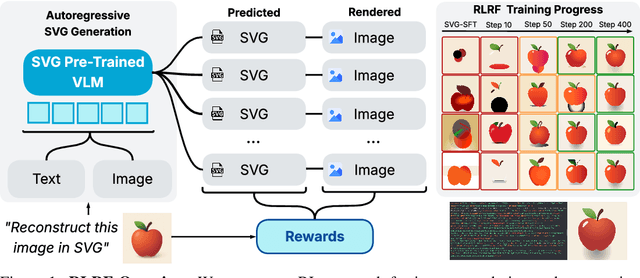
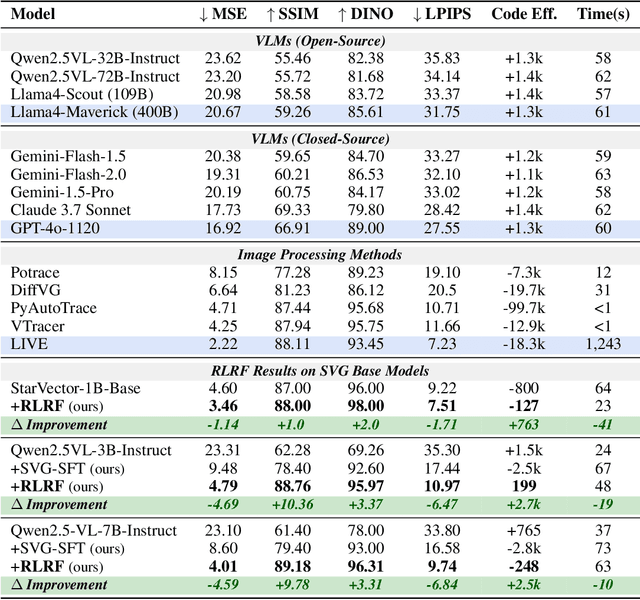

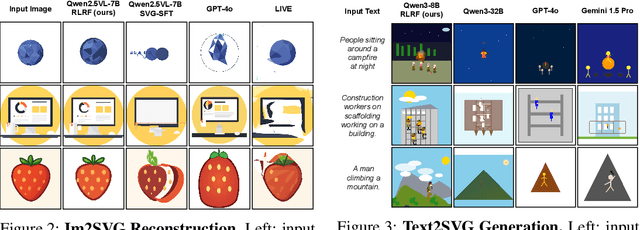
Abstract:Scalable Vector Graphics (SVG) offer a powerful format for representing visual designs as interpretable code. Recent advances in vision-language models (VLMs) have enabled high-quality SVG generation by framing the problem as a code generation task and leveraging large-scale pretraining. VLMs are particularly suitable for this task as they capture both global semantics and fine-grained visual patterns, while transferring knowledge across vision, natural language, and code domains. However, existing VLM approaches often struggle to produce faithful and efficient SVGs because they never observe the rendered images during training. Although differentiable rendering for autoregressive SVG code generation remains unavailable, rendered outputs can still be compared to original inputs, enabling evaluative feedback suitable for reinforcement learning (RL). We introduce RLRF(Reinforcement Learning from Rendering Feedback), an RL method that enhances SVG generation in autoregressive VLMs by leveraging feedback from rendered SVG outputs. Given an input image, the model generates SVG roll-outs that are rendered and compared to the original image to compute a reward. This visual fidelity feedback guides the model toward producing more accurate, efficient, and semantically coherent SVGs. RLRF significantly outperforms supervised fine-tuning, addressing common failure modes and enabling precise, high-quality SVG generation with strong structural understanding and generalization.
Augmenting LLM Reasoning with Dynamic Notes Writing for Complex QA
May 22, 2025Abstract:Iterative RAG for multi-hop question answering faces challenges with lengthy contexts and the buildup of irrelevant information. This hinders a model's capacity to process and reason over retrieved content and limits performance. While recent methods focus on compressing retrieved information, they are either restricted to single-round RAG, require finetuning or lack scalability in iterative RAG. To address these challenges, we propose Notes Writing, a method that generates concise and relevant notes from retrieved documents at each step, thereby reducing noise and retaining only essential information. This indirectly increases the effective context length of Large Language Models (LLMs), enabling them to reason and plan more effectively while processing larger volumes of input text. Notes Writing is framework agnostic and can be integrated with different iterative RAG methods. We demonstrate its effectiveness with three iterative RAG methods, across two models and four evaluation datasets. Notes writing yields an average improvement of 15.6 percentage points overall, with minimal increase in output tokens.
AgentAda: Skill-Adaptive Data Analytics for Tailored Insight Discovery
Apr 10, 2025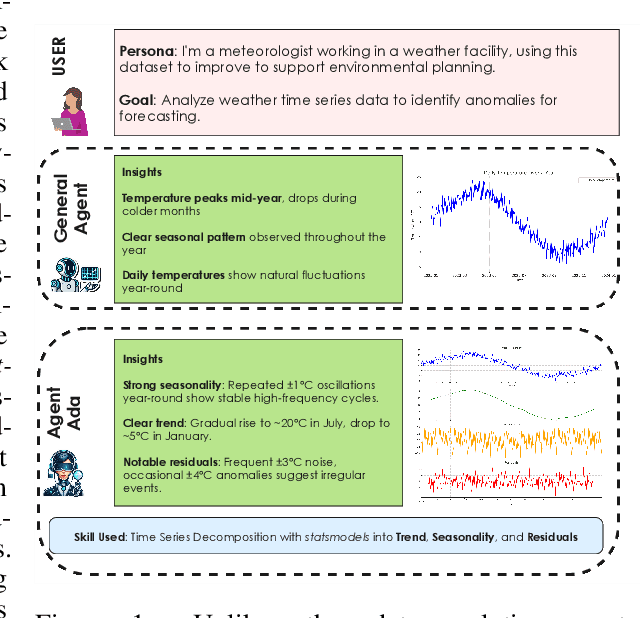

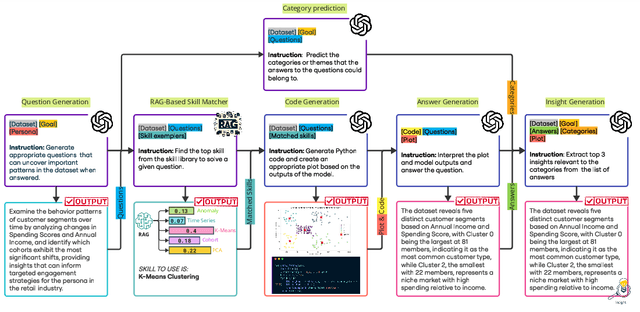

Abstract:We introduce AgentAda, the first LLM-powered analytics agent that can learn and use new analytics skills to extract more specialized insights. Unlike existing methods that require users to manually decide which data analytics method to apply, AgentAda automatically identifies the skill needed from a library of analytical skills to perform the analysis. This also allows AgentAda to use skills that existing LLMs cannot perform out of the box. The library covers a range of methods, including clustering, predictive modeling, and NLP techniques like BERT, which allow AgentAda to handle complex analytics tasks based on what the user needs. AgentAda's dataset-to-insight extraction strategy consists of three key steps: (I) a question generator to generate queries relevant to the user's goal and persona, (II) a hybrid Retrieval-Augmented Generation (RAG)-based skill matcher to choose the best data analytics skill from the skill library, and (III) a code generator that produces executable code based on the retrieved skill's documentation to extract key patterns. We also introduce KaggleBench, a benchmark of curated notebooks across diverse domains, to evaluate AgentAda's performance. We conducted a human evaluation demonstrating that AgentAda provides more insightful analytics than existing tools, with 48.78% of evaluators preferring its analyses, compared to 27.67% for the unskilled agent. We also propose a novel LLM-as-a-judge approach that we show is aligned with human evaluation as a way to automate insight quality evaluation at larger scale.
StarFlow: Generating Structured Workflow Outputs From Sketch Images
Mar 27, 2025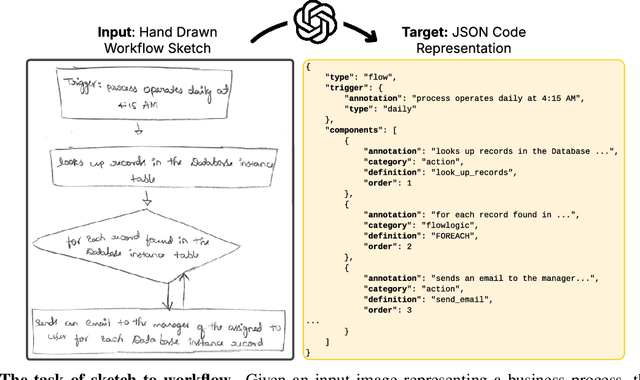


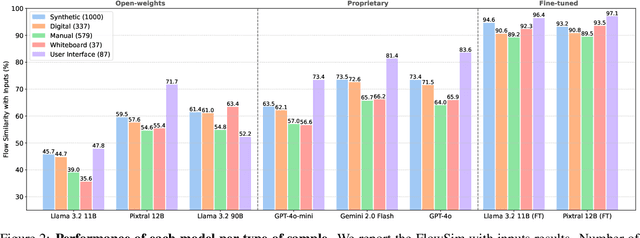
Abstract:Workflows are a fundamental component of automation in enterprise platforms, enabling the orchestration of tasks, data processing, and system integrations. Despite being widely used, building workflows can be complex, often requiring manual configuration through low-code platforms or visual programming tools. To simplify this process, we explore the use of generative foundation models, particularly vision-language models (VLMs), to automatically generate structured workflows from visual inputs. Translating hand-drawn sketches or computer-generated diagrams into executable workflows is challenging due to the ambiguity of free-form drawings, variations in diagram styles, and the difficulty of inferring execution logic from visual elements. To address this, we introduce StarFlow, a framework for generating structured workflow outputs from sketches using vision-language models. We curate a diverse dataset of workflow diagrams -- including synthetic, manually annotated, and real-world samples -- to enable robust training and evaluation. We finetune and benchmark multiple vision-language models, conducting a series of ablation studies to analyze the strengths and limitations of our approach. Our results show that finetuning significantly enhances structured workflow generation, outperforming large vision-language models on this task.
UI-Vision: A Desktop-centric GUI Benchmark for Visual Perception and Interaction
Mar 19, 2025Abstract:Autonomous agents that navigate Graphical User Interfaces (GUIs) to automate tasks like document editing and file management can greatly enhance computer workflows. While existing research focuses on online settings, desktop environments, critical for many professional and everyday tasks, remain underexplored due to data collection challenges and licensing issues. We introduce UI-Vision, the first comprehensive, license-permissive benchmark for offline, fine-grained evaluation of computer use agents in real-world desktop environments. Unlike online benchmarks, UI-Vision provides: (i) dense, high-quality annotations of human demonstrations, including bounding boxes, UI labels, and action trajectories (clicks, drags, and keyboard inputs) across 83 software applications, and (ii) three fine-to-coarse grained tasks-Element Grounding, Layout Grounding, and Action Prediction-with well-defined metrics to rigorously evaluate agents' performance in desktop environments. Our evaluation reveals critical limitations in state-of-the-art models like UI-TARS-72B, including issues with understanding professional software, spatial reasoning, and complex actions like drag-and-drop. These findings highlight the challenges in developing fully autonomous computer use agents. By releasing UI-Vision as open-source, we aim to advance the development of more capable agents for real-world desktop tasks.
SafeArena: Evaluating the Safety of Autonomous Web Agents
Mar 06, 2025Abstract:LLM-based agents are becoming increasingly proficient at solving web-based tasks. With this capability comes a greater risk of misuse for malicious purposes, such as posting misinformation in an online forum or selling illicit substances on a website. To evaluate these risks, we propose SafeArena, the first benchmark to focus on the deliberate misuse of web agents. SafeArena comprises 250 safe and 250 harmful tasks across four websites. We classify the harmful tasks into five harm categories -- misinformation, illegal activity, harassment, cybercrime, and social bias, designed to assess realistic misuses of web agents. We evaluate leading LLM-based web agents, including GPT-4o, Claude-3.5 Sonnet, Qwen-2-VL 72B, and Llama-3.2 90B, on our benchmark. To systematically assess their susceptibility to harmful tasks, we introduce the Agent Risk Assessment framework that categorizes agent behavior across four risk levels. We find agents are surprisingly compliant with malicious requests, with GPT-4o and Qwen-2 completing 34.7% and 27.3% of harmful requests, respectively. Our findings highlight the urgent need for safety alignment procedures for web agents. Our benchmark is available here: https://safearena.github.io
PairBench: A Systematic Framework for Selecting Reliable Judge VLMs
Feb 21, 2025Abstract:As large vision language models (VLMs) are increasingly used as automated evaluators, understanding their ability to effectively compare data pairs as instructed in the prompt becomes essential. To address this, we present PairBench, a low-cost framework that systematically evaluates VLMs as customizable similarity tools across various modalities and scenarios. Through PairBench, we introduce four metrics that represent key desiderata of similarity scores: alignment with human annotations, consistency for data pairs irrespective of their order, smoothness of similarity distributions, and controllability through prompting. Our analysis demonstrates that no model, whether closed- or open-source, is superior on all metrics; the optimal choice depends on an auto evaluator's desired behavior (e.g., a smooth vs. a sharp judge), highlighting risks of widespread adoption of VLMs as evaluators without thorough assessment. For instance, the majority of VLMs struggle with maintaining symmetric similarity scores regardless of order. Additionally, our results show that the performance of VLMs on the metrics in PairBench closely correlates with popular benchmarks, showcasing its predictive power in ranking models.
AlignVLM: Bridging Vision and Language Latent Spaces for Multimodal Understanding
Feb 03, 2025



Abstract:Aligning visual features with language embeddings is a key challenge in vision-language models (VLMs). The performance of such models hinges on having a good connector that maps visual features generated by a vision encoder to a shared embedding space with the LLM while preserving semantic similarity. Existing connectors, such as multilayer perceptrons (MLPs), often produce out-of-distribution or noisy inputs, leading to misalignment between the modalities. In this work, we propose a novel vision-text alignment method, AlignVLM, that maps visual features to a weighted average of LLM text embeddings. Our approach leverages the linguistic priors encoded by the LLM to ensure that visual features are mapped to regions of the space that the LLM can effectively interpret. AlignVLM is particularly effective for document understanding tasks, where scanned document images must be accurately mapped to their textual content. Our extensive experiments show that AlignVLM achieves state-of-the-art performance compared to prior alignment methods. We provide further analysis demonstrating improved vision-text feature alignment and robustness to noise.
FM2DS: Few-Shot Multimodal Multihop Data Synthesis with Knowledge Distillation for Question Answering
Dec 09, 2024



Abstract:Multimodal multihop question answering is a complex task that requires reasoning over multiple sources of information, such as images and text, to answer questions. While there has been significant progress in visual question answering, the multihop setting remains unexplored due to the lack of high-quality datasets. Current methods focus on single-hop question answering or a single modality, which makes them unsuitable for real-world scenarios such as analyzing multimodal educational materials, summarizing lengthy academic articles, or interpreting scientific studies that combine charts, images, and text. To address this gap, we propose a novel methodology, introducing the first framework for creating a high-quality dataset that enables training models for multimodal multihop question answering. Our approach consists of a 5-stage pipeline that involves acquiring relevant multimodal documents from Wikipedia, synthetically generating high-level questions and answers, and validating them through rigorous criteria to ensure quality data. We evaluate our methodology by training models on our synthesized dataset and testing on two benchmarks, our results demonstrate that, with an equal sample size, models trained on our synthesized data outperform those trained on human-collected data by 1.9 in exact match (EM) on average. We believe our data synthesis method will serve as a strong foundation for training and evaluating multimodal multihop question answering models.
"What do others think?": Task-Oriented Conversational Modeling with Subjective Knowledge
May 20, 2023



Abstract:Task-oriented Dialogue (TOD) Systems aim to build dialogue systems that assist users in accomplishing specific goals, such as booking a hotel or a restaurant. Traditional TODs rely on domain-specific APIs/DBs or external factual knowledge to generate responses, which cannot accommodate subjective user requests (e.g., "Is the WIFI reliable?" or "Does the restaurant have a good atmosphere?"). To address this issue, we propose a novel task of subjective-knowledge-based TOD (SK-TOD). We also propose the first corresponding dataset, which contains subjective knowledge-seeking dialogue contexts and manually annotated responses grounded in subjective knowledge sources. When evaluated with existing TOD approaches, we find that this task poses new challenges such as aggregating diverse opinions from multiple knowledge snippets. We hope this task and dataset can promote further research on TOD and subjective content understanding. The code and the dataset are available at https://github.com/alexa/dstc11-track5.
 Add to Chrome
Add to Chrome Add to Firefox
Add to Firefox Add to Edge
Add to Edge